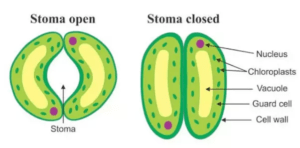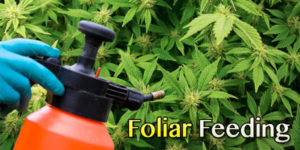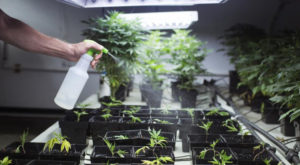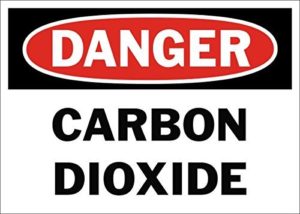 To compensate for plant CO2 consumption inside the greenhouse and to boost the levels beyond outdoor ambient to create higher yield, a lot of studies have gone into the benefits and risks of adding this gas to greenhouse crops.
To compensate for plant CO2 consumption inside the greenhouse and to boost the levels beyond outdoor ambient to create higher yield, a lot of studies have gone into the benefits and risks of adding this gas to greenhouse crops.
Most growers already have an interest in providing more CO2 for their crops but may not quite understand what’s going on inside the plant. Knowing this can make a world of difference in how successful a response you get from doing this.
To pursue an investigation into options for CO2 enhancement, a bit of background on just how CO2 gets into the plant would be useful. Primarily, carbon dioxide enters a plant through the specialized cells that make up the stomata. These are located on the underside of the leaves of most plants.
After entering the plant tissue, the CO2 becomes useful through a process called diffusion. Stomata are kind of like tiny little mouths that open and close, and when open they allow a transfer of gas and moisture. This is where transpiration occurs; the release of moisture, as well as the exchange of ‘oxygen out and carbon dioxide in.’
The greater uptake of carbon dioxide by the plant the better its photosynthesis process will be and from this, plant vigor improves. So, with more CO2 we have a greater yield, but to get this vital nutrient into our crop it must both be available and the plant must have active or open stomata.

Factors that influence the stomata are ambient air and leaf temperatures; light levels; humidity; water stress; and carbon dioxide concentration inside the plant. Stomata close during darkness and in periods of drought stress. The ‘guard’ cells do the work of opening and closing the stomata.
There is no value in raising the ambient CO2 level in the greenhouse or tent when it is dark. The same is true when a plant is in drought stress because the plant is trying to conserve water. The stomata are closed to reduce moisture loss. Save your time and resources in either of these cases.
When CO2 is finally absorbed into a plant it must be diffused into the spongy mesophyll cells. The distance that any gas must diffuse into even a large plant is not far, as every living cell is located close to the surface. Interior cells (used for structure) are no longer living.

The gas exchange happens in the spongy mesophyll tissue of the leaf. These cells are covered with moisture and loosely packed, making gaseous movement easier. These aspects help make carbon dioxide diffuse into the spongy mesophyll cells while allowing oxygen to transfer out. Stomata openings are typically less than 20×10 microns.
So, getting the crop to grow more vigorously by adding CO2 requires that we do this in such a way and time that the stomata are open. High photosynthesis is often occurring during the heat and so the plant may be in a drought condition.
In this event, through photosynthesis is very active the stomata are closed or mostly closed and added CO2 is not benefiting them. Early in the light cycle would seem to be an optimum time for added CO2. The plant’s photosynthesis is completely active and its tissues are still filled with water moisture. Later in the lifecycle, this moisture aspect may no longer be true.
How Does CO2 Help Produce Vigor?

Biological chemistry! The oxygen from CO2 gets incorporated into the carbohydrates created by the plant. Most plants produce phosphoglyceric acid (with three atoms–C3), while others produce aspartic acid (with four atoms–C4) from the photosynthesis process.
C4 category plants developed as early as 12 million years ago and tolerate heat better and so dominate the tropical regions, while C3 plants developed as long as 3.5 billion years ago and are mostly temperate. Each of these two categories responds to CO2 differently.
Growth Increase from a 100% Increase in the Level of CO2
| Plant Type | Growth Increase |
| C3 | 41% |
| C4 | 22% |
About 95% of all plants are type C3, while C4 makes up less than 2%. So, it is likely that the crop being grown by the reader is C3 and will likely experience a 41% increase in growth with a 100% increase in available CO2. The benefits would seem to be insurmountably obvious.
Again, a major influence and aspect of how much-added growth is going to be related to the amount of time during daylight that the stomata are open. Drought-tolerant plants (C4) are prone to reduced periods of open stomata and this is why they handle drought better but would be less affected by increased CO2.

Enhanced CO2 also has the effect of narrowing the stomata and so will help (due to a narrow aperture) reduce the pollutants that can get into the plant. Another benefit! Photosynthesis is vital to utilize the CO2 diffused into the plant, the presence of enhanced CO2 for plants grown in lower light levels is greater than for plants grown in higher light levels.
This is because the CO2 itself will assist in boosting photosynthesis. The evidence of winning this debate is found in that many greenhouse growers increase the level of CO2 to three times what is found in the atmosphere. The benefits from enhanced CO2 are many and mostly without much debate within the industry.
Most every grower wants to provide more of this vital molecule to their cannabis crop and is looking for ways to do this; safely and economically.
Using CO2 for Foliar Feeding
 Now let’s consider a practice that also fascinates me – foliar feeding with added CO2. With this technique, the grower is applying both nutrients and CO2 (truly a form of nutrient) directly to the leaf tissue. The response can be very fast and dramatic. How to infuse the nutrient with CO2 has a couple of options that are being practiced.
Now let’s consider a practice that also fascinates me – foliar feeding with added CO2. With this technique, the grower is applying both nutrients and CO2 (truly a form of nutrient) directly to the leaf tissue. The response can be very fast and dramatic. How to infuse the nutrient with CO2 has a couple of options that are being practiced.
A carbonated liquid nutrient is one way to provide nutrients and CO2 at the same time. Carbonation is simply CO2 added and diffused into the liquid. As this carbonated liquid is opened to ambient air, bubbles will be seen coming off from the liquid and this is the release of CO2 into the air.
Within the liquid nutrient there are millions of tiny bubbles of CO2 gas, and when exposed to low atmospheric pressure, these tiny bubbles group together, float to the surface, and reunite with the atmosphere. For this reason, the grower using this type of carbonated nutrient will want to keep the lid on the nutrient container or bottle as much as possible to keep the level of carbon dioxide as high as possible for as long as possible.
When a carbonated liquid nutrient (containing carbon dioxide) is applied to living plant tissue both the liquid nutrient and the dissolved CO2 gas are taken into the plant and then diffuse into the various cells. With a single function performed by the grower, both the CO2 and nutrient needs of the plant have been satisfied. Two birds, one stone!

The complication with trying to use a pump sprayer pressurized by CO2 (taking the place of an air hand pump) is that the gas sits atop the liquid and is not diffused with the nutrient spray when released from the sprayer. The gas needs to be mixed, either in the chamber of the sprayer or through aspiration at the outlet.
Hose end sprayers do aspirate the nutrient but use water force, not gas to propel the mixture out of the sprayer and onto the plant. A sprayer that aspirates with gas pressure would work, but I do not know where to obtain these.
Nonetheless, it is a very convenient technique to combine the function of foliar nutrients with CO2 application however one may accomplish this. Remember; photosynthesis makes the diffusion process possible, so make the application at the right time.
Because photosynthesis itself is boosted through the enhanced availability of CO2, this in effect will reduce the requirement of light energy to gain the same amount of growth. This can be very cost-effective. Not only is maximum yield our goal, but optimum economy to go along with this added yield. So, added CO2 can help save on your energy bill.
CO2 and Your Safety
 Using gaseous CO2 has its risks if you are not careful in what you are doing. In an enclosed area, when the CO2 level exceeds 5,000 Parts-per-Million (PPM) it can cause dizziness and loss of coordination in humans, and levels higher than this can cause death for humans and plant tissue necrosis for some plant species.
Using gaseous CO2 has its risks if you are not careful in what you are doing. In an enclosed area, when the CO2 level exceeds 5,000 Parts-per-Million (PPM) it can cause dizziness and loss of coordination in humans, and levels higher than this can cause death for humans and plant tissue necrosis for some plant species.
Consider that 5,000 PPM is only 0.5%. If one adds 4 cubic feet of CO2 gas to a room the size of 8 x 10 x 10 feet the total CO2 concentration would be increased by 4%. That is not that much gas yet our CO2 level is now borderline dangerous.
You will want to use a good quality CO2 regulator if you intend to provide this vital boost to your crop. Regulators will assure that the gas is applied at the right rate. They generally have built-in timers so that you can avoid feeding CO2 beyond the quantity desired.
Another important piece of equipment is going to be a good monitor with a built-in alarm. The monitor senses the concentration of CO2 fed at any time. The best monitor/controllers will turn on and shut off when programmed levels are reached as well as shut off when programmed.
You will want this monitor to audibly and visually let you know if the levels have exceeded safety or exceeded the levels that you want. As far as the expense of a regulator and monitor, I would ask you to consider how much your health and crop are worth as well as the size of your electric bill.
As CO2 can add 40% or more to growth, it can just as well cut your energy costs considerably. Adding carbon dioxide is an investment much more than an expense.
Let us know what you think.




Responses